https://www.youtube.com/watch?v=XNlUSq_dIsU
With all the CoronaZombies out and about I’ve upped my EDC gun to a Brownells BRN-180S upper on their BRN-180M lower (review coming soon). Chambered in .223 Wylde and in my case shooting either 5.56 NATO or .223 Remington, this beast needed to be suppressed . . . but in the most compact, unobtrusive way possible.
Cue the Yankee Hill Machine Turbo K.
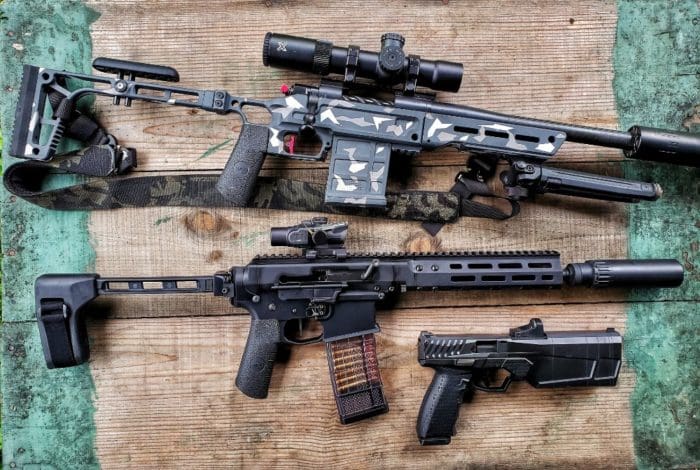
Long range / hunting on top (Black Collar Arms Pork Sword), “home defense” in the middle (BRN-180S pistol with FS1913 brace), and personal defense at bottom (SilencerCo Maxim 9). Amirite? All suppressed, all the time.
Thanks to Silencer Shop for loaning me this YHM Turbo K for review. They make the process easier than anyone else in the country and have the best pricing on the most suppressors. Check them out!
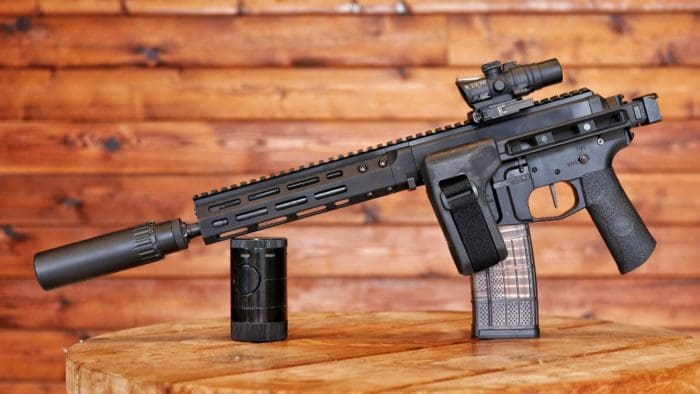
Here’s the deal. There are some suppressors on the market that aren’t designed to be as quiet as possible. Rather, they’re made to be as compact and lightweight as possible while remaining just this side of the generally-accepted 140 dB “hearing safe” threshold. This is where the YHM Turbo K lives.
In my experience, this is also where most experienced suppressor owners and shooters end up. We all start out chasing dB numbers and looking for the quietest thing around, but after actually using the darn things, a lot we all gravitate toward smaller cans. Especially for a defensive weapon.
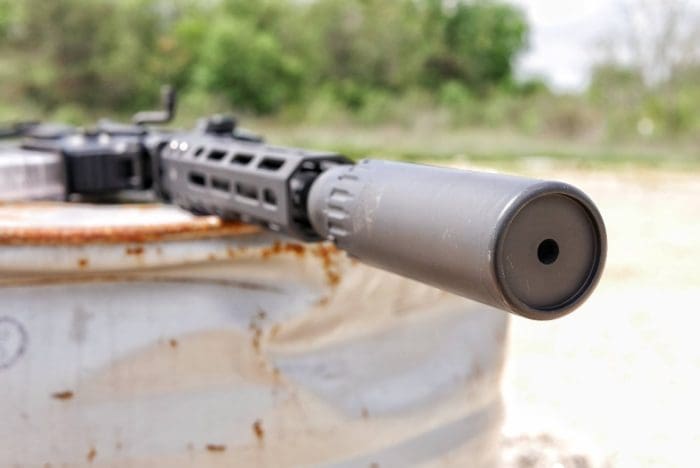
This YHM Turbo K is the original model, whereas the ones shipping currently are v2.0 with a more aesthetically exciting, better-at-flash-hiding muzzle end. Sound suppression is the same, though.
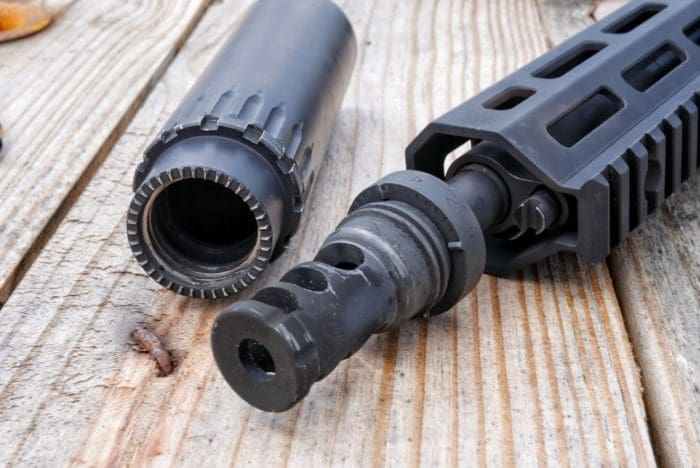
Included with the YHM Turbo K is a 1/2×28 muzzle brake or flash hider QD mount, and the corresponding mount installed in the suppressor. A spring-loaded collar pushes four detents into the suppressor-side mount, preventing it from coming loose while shooting.
This is a very simple, efficient, full-auto-rated design needing only about one-and-a-half rotations to go from removed to fully tightened or vice versa.
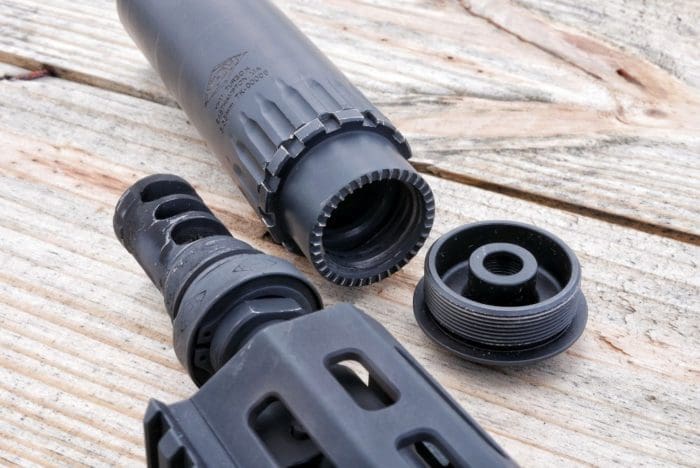
The Turbo K works with all YHM legacy mounts, too. Better yet, its tube features what has become the industry standard mounting size of 1.375×24 (1-3/8×24) threads. That means the YHM Turbo K is compatible with literally dozens of mounting systems from lots of other companies, including Dead Air, Q, SilencerCo, and so darn many more.
Whether you want to go direct thread to save weight or use another company’s QD system, your options are wide open.
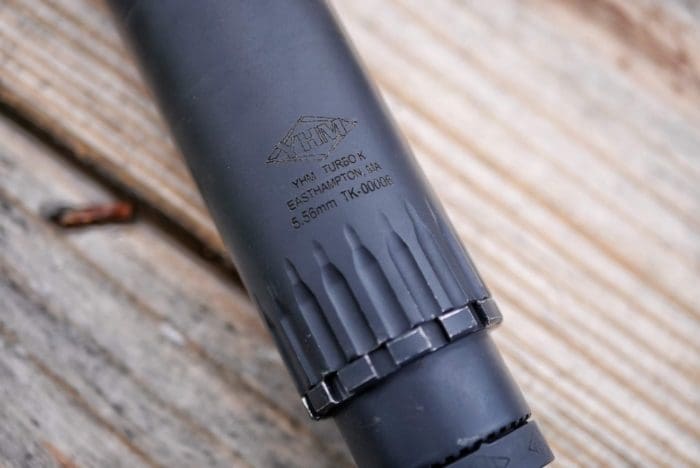
To achieve that full-auto rating, the Turbo K employs an Inconel blast baffle and 17-4 PH stainless steel everything else. And by “everything else” I mean both other baffles.
Yeah, there are only three baffles in this unique, tubeless design. It’s amazing how open this suppressor actually is on the inside.
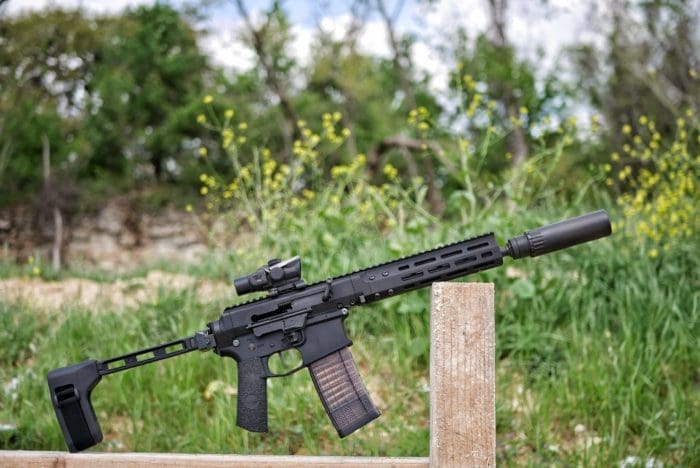
And, of course, that leads to the Turbo K’s light weight of just 8.83 ounces. Or, with the QD mount system seen here, 11.7 ounces. For an Inconel and 17-4 can, this is incredibly lightweight.

Yankee Hill Machine’s Turbo-K is also only 4.75 inches long should you go with a flush, direct thread mount as seen a few photos up. With the QD mount seen in the rest of the photos, it’s still only 5.5 inches long. My wife didn’t find this impressive, but I’m quite pleased.
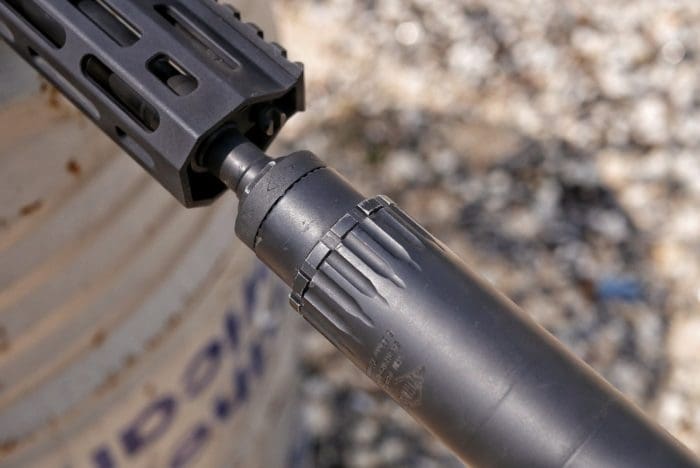
Two wrenches are included with the Turbo K to assist with removing the mounts and such. Most of the time I was able to do it by hand, though, as the 5.56-shaped grooves at the base of the suppressor are more than just cool looking, they’re grippy.
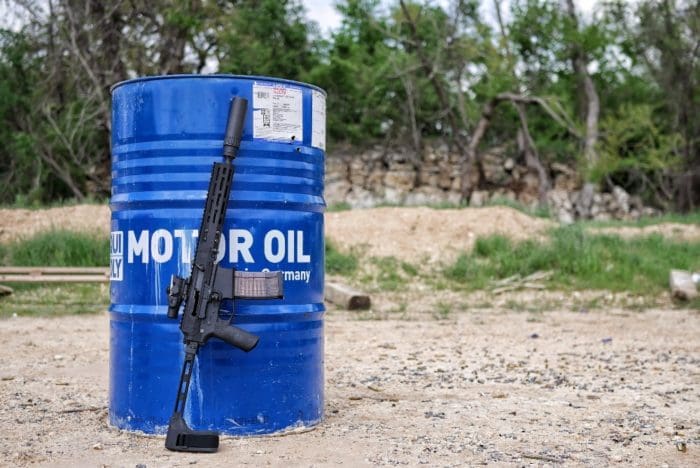
Out on the range the YHM Turbo K does exactly what you’d hope. It completely and totally eliminates all blast and concussion and greatly reduces muzzle flash. Naturally, it also reduces sound levels down to below that 140 dB threshold with a mil-spec test rating of about 138 dB.
Accuracy was either not affected or actually slightly improved with the addition of the Turbo K. Though I missed a couple coyotes at approximately 650 yards (they were way out in a pasture waiting for a cow to give birth so they could eat the calf), I came close enough to scare them off. Way off.
My hunting buddy nabbed another coyote with this setup, and shots on steel at 100 yards remained tight and on the 12″x12″ target regardless of whether the suppressor was attached or not.
At the shooter’s ear on a 10.5-inch semi-auto like the BRN-180S the YHM Turbo K certainly isn’t what you’d call quiet, but it causes no discomfort and is just what the doctor ordered for hunting or for the Flu Manchu boogaloo.
Combine the performance and features with an MSRP of just $485 and a going rate from Silencer Shop of only about $375, and the Turbo K is a clear standout and “best buy” in the realm of compact 5.56 suppressors.
Specifications: YHM Turbo K
Caliber: .223 Remington / 5.56 NATO
Diameter: 1.562″
Length: 4.75″ without mount. 5.5″ with QD adapter
Weight: 8.83 ounces without mount. 11.7 ounces with QD adapter
Mount Type: accepts 1-3/8×24 mounts
Materials: Inconel blast baffle, 17-4 PH SS everything else. Tubeless
Full Auto Rated: Yes
Decibel Rating: 138 dB
MSRP: $485
Ratings (out of five stars):
Utility * * * *
While a dedicated 5.56 suppressor is a fairly niche product by default, the tough construction and the 1.375×24 mounting system on the Turbo K are easily worth an above-average rating in the utility category.
Suppression * * * *
Achieving sub-140 dB performance out of a 5.56 can this small and this lightweight, yet still full-auto rated, is impressive, indeed.
Overall * * * *
Yankee Hill Machine’s Turbo K earns a very strong four stars. Heck, I’d happily call it four-and-a-half. The Turbo K is everything a defensive use 5.56 suppressor should be with the bonus of a universal mounting system and a low price point as cherries on top. It’s a fantastic choice to protect your homestead from the hordes of Kung Flu victims coming for your toilet paper.
All images by Jeremy S. for TTAG.

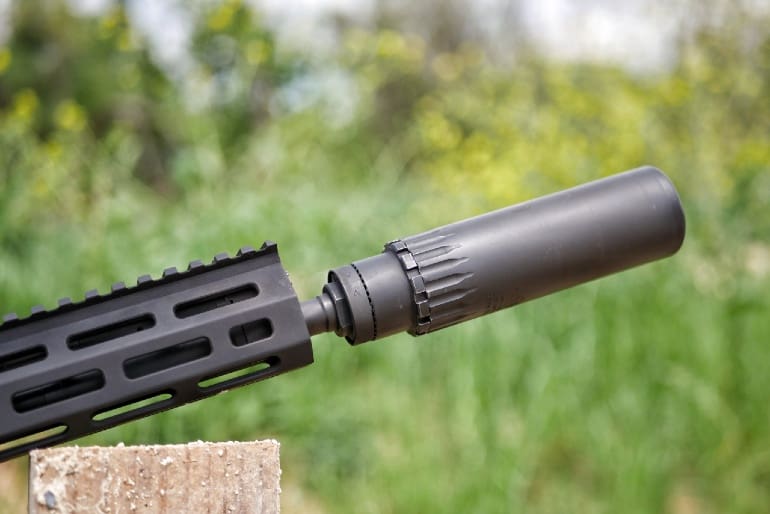



Any word on whether the ATF is still chugging through Form 4s?
My semi local shop said about 6 months when I asked a few weeks ago. I imagine the Coronapocolyose has had only a minimal impact on that particular section of our favorite feds.
Your shop is … optimistic. At least in my experience.
When you say causes no discomfort at the shooter’s ear on the 10.5” barrel, are you talking about without hearing protection on?
And am I the only one who still has to enter my name and email every time I comment?
double click on the name/ mail areas. should populate.
I don’t know what it is, but double clicking doesn’t work for me 🤷♂️
Without ear pro. YMMV depending on host firearm, shooting location, etc.
I’m guessing if the 138db was measured military style…1 meter away from the muzzle…the dB at your ear was significantly higher with an AR platform. A lot of noise comes out of the ejection port
That is highly dependent on the suppressor and the gun. On a gas piston design like the BRN-180, which also doesn’t have a rear charging handle or a buffer tube, it’s going to be much lower already vs. a normal, direct impingement AR. Then it’s a matter of the backpressure generated by the suppressor, with low backpressure or “flow-through” designs being quieter at the shooter’s ear than more typical designs with lots of baffles and restriction and therefore higher backpressure. The Turbo K isn’t a “flow-through,” but it’s far more open inside than most suppressors, including having a heavily ported blast baffle and a massive blast chamber, which drops pressure rapidly and then there are only two baffles after that. My impression of it was that it has meaningfully lower backpressure than most 5.56 suppressors. Especially compared to larger ones.
I do believe that, on this setup, it was quieter at the shooter’s ear than one meter to either side of the muzzle where your mil-spec dB measuring occurs. While I didn’t meter it, I did shoot the gun quite a bit myself and I also stood next to it while my hunting buddy was shooting.
Interesting. I forgot that the BRN-180S is a piston, which would definitely take away much of the sound from the ejection port. Looking forward to the article you mentioned in your reply to someone else!
Interesting. I forgot that the BRN-180S is a piston, which would definitely take away much of the sound from the ejection port. Looking forward to the article you mentioned in your reply to someone else!
Ahh, I forgot the BRN-180S is a piston system…would definitely make a difference vs the standard AR system.
Also, looking forward to the article you mentioned in another comment!
Yep I ask the same question on ear pro? And I only need enter my info on my first coment of the session and the next one auto fills. But if I close out and come back then I have to reenter my info.
And I’m waiting for a suppressor capable of reducing noise levels closer to 100db as my hearing really can’t take much more abuse.
My DDM4V7 looks awesome with the purolator 1 on it..no paperwork…no wait time
Last around 700 rds…paint it black for tactical reasons only. Awwwwright
The BRN-180 is a pretty neat setup. Brownells is making some great stuff. 140db is still loud, but much better than without. I wish the NFA didn’t exist so I could buy cans and actually use them, rather than have them sit in jail for 9 months. This Corona virus stuff is going to screw us over. Especially if you live in VA when they try to shove that AWB and silencer ban through here in January again.
next session is shorter by half. 30 days vs 60 for this last session.
The 138dB of this can at the ear will cause permanent and non-reversable hearing damage, as will 133 &135. The 140 limit by OSHA is for a one time exposure, not repeated exposure of semi-auto fire in a shooting session. Lower than 140 is cumulative in effect. If you want to shoot suppressed and not wear any earpro at all stick to .22 or subsonic 9mm with a good can, not a three inch miracle…
OSHA does not consider impulse noises to be cumulative unless they are continuous and occurring at a rate of more than one per second. If they are less frequent than that then the max safety threshold is 140 dB and there is no stated maximum exposure since it isn’t cumulative according to OSHA.
That isn’t truly correct, though, and you’re going to see A LOT more data starting tomorrow on how gunshots actually affect hearing and how much exposure is safe. A new company launches tomorrow and they have the most incredible data on unsuppressed and suppressed gunshots as they pertain to hearing damage / safety that has ever been done. Looking not just at peak dB, of course, but at total exposure (more or less “area under the curve” stuff taking into account the duration of the increased volume and the entire waveform, etc) and more. It will actually rank this stuff and is capable of suggesting, for instance, a maximum of 26 shots from a given firearm + suppressor setup per X-hour period, etc etc., to prevent cumulative hearing damage from occurring. This is one of the big goals of the endeavor; to move away from dB ratings and into something that’s easier to understand, which is a sound exposure safety scale.
Good to hear. I have partial hearing loss in my left ear from 1 gunshot. Just one shot. One week before Michigan opener my step dad asked me to check zero on his Savage .270 win. Someone thought it was a good idea to port the barrel into a muzzle break. I knew better, but thought what the hell 1 shot won’t hurt. If I needed to sight in I could grab my ear pro.(bench about 40 yatds from the house) I shot dead center of the target. Instantly completely deafness in my left ear that lasted about 3 hours. I suffered about 2 months of tinnitus. It went away and now I have difficulty hearing when there is any additional noise around me. Now I always use ear pro, even when hunting.
That was probably in the 170 dB range. An unsuppressed gunshot will absolutely cause immediate, permanent hearing damage.
A suppressor is basically moving the hearing protection from on your head to on your gun. In nearly all cases if I’m at the range, even if I’m alone out there, I’m shooting suppressed AND wearing ear pro (electronic plugs or a bluetooth headset so I can listen to a podcast or something). Hearing is important and it doesn’t grow back.
I sustained a significant loss of hearing from just one shot without ear pro. It was caliber 105mm.
I’m 75, each forgetfull shot at the bench increases my hearing difficulty. the last time was a hk91 308 in cold weather. the time before was a 6mm rem semi auto on the front porch under the overhang. each was the one shot with the hp laying on the bench. I use hp every time now except with the 22 rimfire or 300 bo lightloads. I should tie the muffs to the triggerguard to remind me to put them on. I tried some walkers but could not keep them in during running or any bouncing around it seems.
Got them in stock at Shady Oaks Gun Range
How many of these do you suppose James Campbell is going to claim he owns?
“With the QD mount seen in the rest of the photos, it’s still only 5.5 inches long. My wife didn’t find this impressive, but I’m quite pleased.”
Her – “Who do you think you’re gonna please with *that*?”
Him – “Me.” 🙂
So, a new can to be introduced tomorrow, eh? Right when I’m itching to “pull the trigger” on “One Can to Rule them All”?
You’re not exactly making this process easier, Mr. S….
No, no new suppressor is being introduced tomorrow. The thing I was talking about in a previous comment is a new measuring system and ranking system for testing suppressors and presenting the results in an easy-to-understand, WAY more scientific and meaningful manner than anyone has ever done before.
“One can to rule them all” is a pretty hard thing to accomplish. It’ll never be as good at any particular thing as a dedicated suppressor would be on that same thing. However, some suppressors do a fairly good job at working on an absurd number of firearms and cartridges, such as the SilencerCo Hybrid 46 and 36 and the Griffin Bushwhacker 46.
Strych recommended the Ospry in .45 as a potential “One Can”…
Well, maybe for most pistol calibers. You cannot shoot any rifle stuff through the Osprey except for subsonic 300 Blackout with barrel length and rate of fire limitations.
With a Hybrid 46 you can shoot every .45 and smaller pistol cartridge ever plus every rifle cartridge with a .45 or smaller bullet and a power level at and under that of .338 Lapua Magnum. Same story with the Bushwhacker.
Decisions, decisions…
my 45 can is way fatter than the other cans.
I will tell any new prospective buyers that I would research the new hybrid cans that have the serial no on a part that doesn’t get hurt with a baffle strike and one that is multi calibers. more parts and more money but one tax stamp and the parts are replaceable.
Can you remove the hand guard for cleaning with this YHM QD Installed?
probably not. my handguards barley will go over adj gas blocks.
oh yeah all my ar types are piston guns mostly with the adams kits. I like a adj gas block to tune the gun to the ammo and recoil is much less. I guess there is a little noise from the gas port though. my alex arms 6.5 grendel is the hardest to tune it seems with a 308 phantom can converted to piston using the cheap tula/hornady ammo.
I just got my turbok after 10 months. the adapter seems looser than all my other yhm adapters, thats what brought me here for reviews, I haven’t put it on a barrel yet so that might help with the tightening, I put some clr on it to maybe help loosen the spring up, it seems to be stuck probably from the year it set up. I squirted clr down in the baffels also to let it soak to try to make it easier to clean when the time comes I bet it will smoke awhile like the others. It will be a interesting comparison to the yhm 308 phantom titanium on the 556 to see the difference. I saw a review that showed 145-148 on a 16 and 10.5 inch pistol so hp will be a must still for me. maybe a suppressor is really just good for bystanders and spotters on high power rifles. I’m probaby gonna want a 10 inch 556 can before it’s over with especially on pistols. there is not much you can do with 3000fps and 55-60k psi.
Comments are closed.